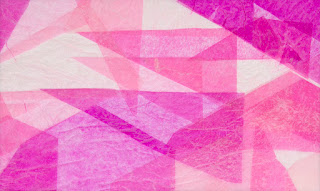I have always had trouble mixing paint colour which is probably way I try to avoid painting and often draw with pencils or pastels. For this exercise I chose three photographs, the bottom strip is of pebbles, the middle rock pool and the top a row of buildings in a side street. I looked through a narrow strip window at a portion of the photograph and tried to reproduce the colours using acrylic paints. This is not my most successful piece in the actual reproduction of the colours but I do like the strip effect.
#1.5.1
I decided to use the colours in the top strip to extend this exercise. I mixed the yellow and blue in increasing proportions and look at the colour range, before cutting the mixes into squares for the next exercises. Again my mixing of the paints was not as successful as I had hoped and I therefore decided to look into colour theories a bit more before moving on.
#1.5.2
I first mixed my own colour wheel using three colours:
- Lemon yellow
- Cadmium red
- Cerulean blue
I was quite pleased with the result, particularly as the full twelve colours were produced from these three primaries. The blue-green range and blue-red range would have benefited from a better mix of colours to achieve a better transition in the hues. I added some brief labels to the wheel so that I can refer back easily to colour theory as I progress through the diploma.
#1.5.3
I mixed white and black to the primaries to produce the various tints/shades; I then mixed the complimentary colours to see what colours were produced.
#1.5.4 #1.5.5
I also decided to read a couple of books on colour theory - Colour: How to use Colour in Art and Design by Edith Anderson Feisner; Interaction of Colour by Josef Albers; and Colour: A Workshop for Artists and Designers by David Hornung. The last book contains a series of assignments to help you understand colour and I might continue to undertake the assignments as I work through the diploma.
I decided to go back to the projects but use colour paper for some of the exercises; this was suggest in one of the books. The next images shows five pages of small colour squares against a different larger coloured square to look at colour perception and the effect of one colour on another when placed next to it.

#1.5.6
Each set of six small squares is A3 size, with the lower set of nine squares also A3 size.
Looking at the squares close-up, I could not see much difference in colours. I had to move the sheet quite a distance to perceive any changes. I also started to think was I was seeing a difference because it was actually there or because I thought I ought to see a difference?
Looking at the squares with the small blue centre, the blue on yellow hues (1, 4 & 5) look darker in tone than the other squares, with blue on green a mid-tone (6) and blue on red (3) and violet (2) the lightest tones. With the blue on red (3), the red seems to recede the most. i would have expected with red being a warmer colour it would move forwards.
With the red inner square, the red appears darker in tone on the orange (7) and yellow (8); and lightest in tone on the lemon yellow (100. The red on green seems most saturated (11).
With the orange centred square, darker tones are produced on violet (14), yellow (15), and green (18). The orange on red (17) and orange on lemon yellow (16) seem more saturated with the one on red (17) receding and the one on the yellow coming forwards.
With the lemon yellow inner squares, darker tones are on the orange and green (19 & 21) and lighter, but more saturated, on the violet and blue (22 & 23).
The small grey squares illustrate the principle of 'after image' in colours. After looking hard for some time I could see some red in the grey on green and violet in the grey on lemon yellow.












